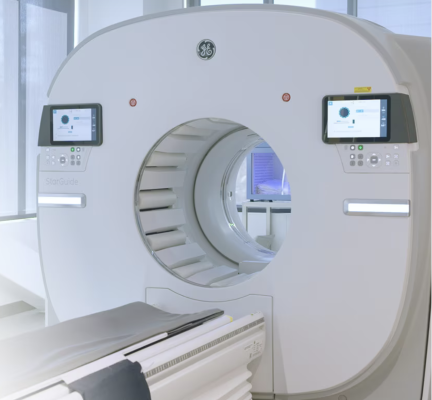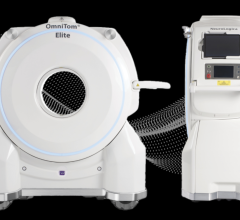
June 3, 2024 — Nova Scotia Health’s QEII Health Sciences Centre is the first health centre in Canada to acquire a StarGuide SPECT/CT scanner by GE HealthCare. The innovative nuclear medicine scanner uses 3-D imaging that can help physicians in diagnosing and treating certain diseases, like cancer and heart disease, with enhanced precision. Access to this new technology can help empower physicians for more accurate diagnoses and informed treatment options for patients.
The $6 million project is being equally funded by QEII Foundation donors and Nova Scotia Health. The QEII Foundation is actively raising $3 million to support the acquisition of two StarGuide scanners as part of the Foundation’s $100-million We Are campaign. The first StarGuide arrived in late May and the first patient will undergo imaging on the scanner by mid-June. The second scanner is currently scheduled to arrive in 2025.
StarGuide represents an advancement in nuclear medicine imaging, offering a 12 CZT detector design that can not only scans patients in 3D to help provide more information to clinicians, but is also optimized for certain Theranostics procedures. The StarGuide SPECT/CT can help clinicians identify the size, shape, and position of lesions with impressive degree of accuracy and will allow physicians to tailor treatments more effectively. With approximately 4,000 nuclear medicine scans performed annually at the QEII, StarGuide has the potential to enable more patients to be scanned each year, helping to address wait times for diagnostic imaging. The advanced technology allows for more efficient imaging, cutting scan times in half for some patients.
Nuclear medicine touches a variety of care areas at the QEII. The two most common diseases imaged in nuclear medicine are cancer and cardiac disease — the two leading causes of death amongst Atlantic Canadians.
Quick Facts:
- The QEII Health Sciences Centre is the first health centre in Canada to acquire a StarGuide SPECT/CT nuclear medicine scanner by GE HealthCare.
- StarGuide is a nuclear medicine scanner that provides 3-D imaging quality to detect certain diseases in the body, like cancer and cardiac disease.
- The SPECT/CT is equipped with a dozen, extendable detectors in a ring design that closely orbits a patient’s body during their scan. This advanced technology enables the detectors to get as close as possible to the patient, narrowing the imaging field of view for precision.
- The QEII Foundation is working with the community to raise funds to support the $3-million fundraising goal for two StarGuide systems at the QEII. This $3-million project is part of the QEII Foundation’s $100-million We Are campaign to transform health care through the QEII Health Sciences Centre.
- The $6 million project is equally funded by QEII Foundation donors and Nova Scotia Health, with government funding operational costs.
- Nuclear medicine is a unique, specialized field within diagnostic imaging. Nuclear medicine scanners use radioactive tracers to light up, locate and diagnose certain diseases in the body. Image quality is critical in nuclear medicine; the more precise the image, the better physicians can assess and diagnose diseases.
- Approximately 4,000 patients undergo nuclear medicine scans at the QEII annually.
- The two most common nuclear medicine scans at the QEII are bone scans to detect and assess cancer and myocardial perfusion scans to assess heart disease. Bone scans currently take 45 minutes and myocardial scans take 15-20 minutes. With the StarGuide system, scan times can be shortened, enabling a better patient experience.[i]
- StarGuide can help to improve the QEII’s ability to perform myocardial perfusion scans – critical tests that show how well blood flows to the muscle of the heart. These scans are the most accurate and non-invasive way to diagnose coronary artery disease.
- The SPECT/CT can also help empower cancer care teams with the images and information needed to spot smaller traces of cancer at earlier stages. This can significantly impact a cancer patient’s treatment journey and overall outcome.
- Better image quality and resolution can help to capture additional information that health care teams need in one scan. This can help reduce the need for patients to return to the hospital multiple times over days or weeks for more scans or tests.
- The two new scanners will replace outdated technology at the QEII. The new technology can help enhance efficiency, which has the potential to enable more patients to be scanned each year – all with the aim of helping address wait lists and wait times for patients who require these types of scans.
- The first of the two StarGuide scanners arrived at the QEII’s Halifax Infirmary in late May. The second scanner will arrive in 2025 and will be installed at the QEII’s Victoria General site.
For more information: www.gehealthcare.com


 July 30, 2024
July 30, 2024 








